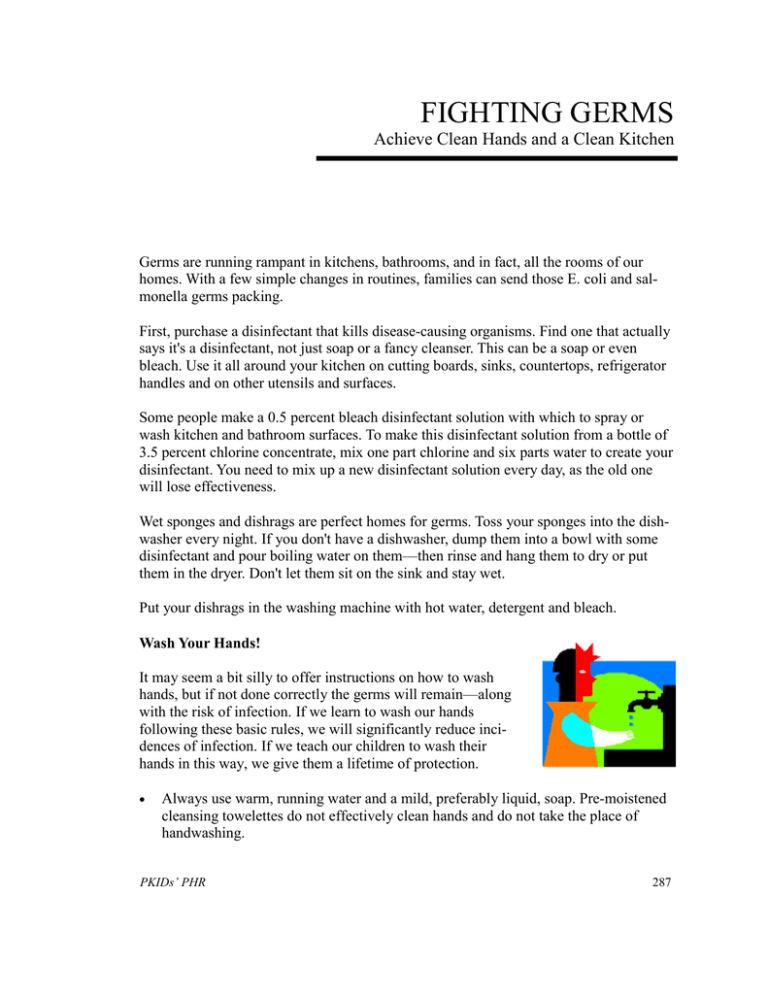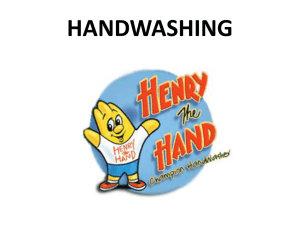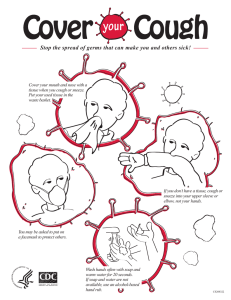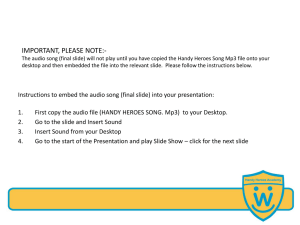fighting germs
advertisement

HANDWASHING FIGHTING GERMS Achieve Clean Hands and a Clean Kitchen Germs are running rampant in kitchens, bathrooms, and in fact, all the rooms of our homes. With a few simple changes in routines, families can send those E. coli and salmonella germs packing. First, purchase a disinfectant that kills disease-causing organisms. Find one that actually says it's a disinfectant, not just soap or a fancy cleanser. This can be a soap or even bleach. Use it all around your kitchen on cutting boards, sinks, countertops, refrigerator handles and on other utensils and surfaces. Some people make a 0.5 percent bleach disinfectant solution with which to spray or wash kitchen and bathroom surfaces. To make this disinfectant solution from a bottle of 3.5 percent chlorine concentrate, mix one part chlorine and six parts water to create your disinfectant. You need to mix up a new disinfectant solution every day, as the old one will lose effectiveness. Wet sponges and dishrags are perfect homes for germs. Toss your sponges into the dishwasher every night. If you don't have a dishwasher, dump them into a bowl with some disinfectant and pour boiling water on them—then rinse and hang them to dry or put them in the dryer. Don't let them sit on the sink and stay wet. Put your dishrags in the washing machine with hot water, detergent and bleach. Wash Your Hands! It may seem a bit silly to offer instructions on how to wash hands, but if not done correctly the germs will remain—along with the risk of infection. If we learn to wash our hands following these basic rules, we will significantly reduce incidences of infection. If we teach our children to wash their hands in this way, we give them a lifetime of protection. • Always use warm, running water and a mild, preferably liquid, soap. Pre-moistened cleansing towelettes do not effectively clean hands and do not take the place of handwashing. PKIDs’ PHR 287 • • • • • • • • • Wet the hands and apply a small amount (dime to quarter size) of liquid soap to hands. Rub hands together vigorously until a soapy lather appears and continue for at least 15 seconds. Sing the ABC song at a moderate tempo while scrubbing—that lasts about 15 seconds. Be sure to scrub between fingers, under fingernails, and around the tops and palms of the hands. Rinse hands under warm running water. Leave the water running while drying hands. Dry hands with a clean, disposable (or single use) towel, being careful to avoid touching the faucet handles or towel holder with clean hands. Turn the faucet off using the towel as a barrier between your hands and the faucet handle. Discard the used towel in a trashcan lined with a fluid-resistant (plastic) bag. Trashcans with foot-pedal operated lids are preferable. Consider using hand lotion to prevent chapping of hands. If using lotions, use liquids or tubes that can be squirted so that the hands do not have direct contact with the container spout. Direct contact with the spout could contaminate the lotion inside the container. When assisting a child in handwashing, either hold the child (if an infant) or have the child stand on a safety step at a height at which the child's hands can hang freely under the running water. Assist the child in performing all of the above steps and then wash your own hands. In 2002, the National Centers for Disease Control and Prevention (CDC) released new guidelines to improve adherence to hand hygiene in healthcare settings. CDC officials recommended the use of alcohol-based handrubs, especially when soap and water are not nearby. Improved handwashing or use of alcohol-based handrubs has been shown to stop outbreaks in healthcare facilities, to reduce transmission of antimicrobial resistant organisms (what some call super bugs) and to reduce overall infection rates. Parents and children also benefit from alcohol handrubs, especially when there is little time or access to soap and running water. Commercial alcohol handrubs can be purchased at stores, or one can be made at home. To create a homemade batch of the handrub, mix: • • 288 Three parts alcohol (either ethanol or isopropanol) Two parts glycerin PKIDs’ PHR HANDWASHING You can put it in a small container and pack it in your purse, backpack or briefcase. To use this handrub, pour enough to cover your thumbnail on one palm, then rub your hands together, covering all of your hands and rubbing until dry. You do not need a towel to dry your hands. You may find that during hot weather the mixture gets too sticky. If this happens, you may add more alcohol. If you find the mixture is too watery, add a little more glycerin. There must be at least 60 percent or three parts alcohol for the handrub to kill germs effectively. If your hands are visibly soiled, you must use soap and water to get them clean. Teaching effective handwashing starts early. Get a stepstool for the smaller kids so they can reach the faucet and soap. Teach them how to wash their hands and make sure they know to do so before and after they eat, after using the toilet, after playing outside, and in general, any time they've been handling anything with germs or whenever their hands look dirty. If children receive positive reinforcement, they'll be happy to wash their hands. Make it fun and sing while they wash. To show them how germs hang on, put some nutmeg in a little bit of petroleum jelly and rub it on their hands before they wash. Explain that the nutmeg represents germs. They'll have to do a good job washing to get rid of the “germs.” A little time spent teaching the basics makes a huge difference in how much time you have to spend caring for a sick child! Currently, debate rages about the effectiveness of antibacterial soap over conventional soap. Historically, plain soap has contained ingredients that helped to physically remove dirt from the skin. An antibacterial soap (more appropriately, antimicrobial that can also be active against fungi and viruses as well as bacteria) contains sufficient amounts of a topical antimicrobial to kill some of these microorganisms. In testimony before the U.S. Food and Drug Administration, doctors reported that antimicrobial soaps were slightly more effective than conventional soap in killing the hepatitis A and polio viruses in handwashing experiments. PKIDs’ PHR 289 However, others contend the common anti-germ agent in antibacterial soaps may cause problems down the line by introducing new germs. Scientists studying Triclosan, the germ killer in these soaps, believe the ingredient could encourage microbacteria to mutate and come back stronger. Dr. Jeoffrey Boscamp, Chief of Pediatric Infectious Diseases at Hackensack University Medical Center, said antibacterial soaps may kill germs too successfully, making it so children won’t be able to develop resistance to them. Others point out that much of the bacteria on the skin are protective. They’re there to prevent harmful bacteria from flourishing and making you ill. If the bacteria aren’t there, they cannot do their job. Scrubbing with antibacterial soap removes the good bacteria along with the bad. Another reason to be wary of these powerful soaps is because they contain a class of chemicals (phenol chlorine derivatives) that are absorbed into the skin and eventually, with long-term use, may find their way into the body's tissues and harm the liver. These chemicals become even more powerful when combined with the chlorine in public water systems. If done correctly, handwashing reduces the rate of bacterial and viral infections by one-third to one-half, with gastrointestinal infections taking the prize by showing a reduction of up to 80 percent. Whichever side of the soap debate you stand on, just grab some soap and start washing. It’s the easiest form of preventive medicine we know. 290 PKIDs’ PHR



